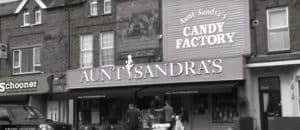Exploring the Bodhrán’s Role in Irish Music and Cultural Identity
Updated On: April 23, 2024 by Maha Yassin
Deeply woven into Irish music and culture fabric is an unassuming yet fiercely captivating instrument: the bodhrán. Steeped in history, the bodhrán is much more than a mere musical accompaniment; it is the pulsating core of Ireland’s musical identity. This traditional drum, deftly manipulated by skilled players’ hands, encapsulates Ireland’s rhythmic spirit—its powerful beats echoing through time and tradition.
Our exploration of the bodhrán unveils its profound influence over the centuries, transcending its humble origins to become emblematic of Irish heritage. Its simple design belies the complex rhythms it produces, rhythms that tell the story of Ireland’s past while continuing to evolve with modern interpretations. As we delve into the bodhrán’s place within the broader palette of Irish music, we discover a symbol of cultural significance that resonates with the heartbeat of a nation.
Origins and History
The Bodhrán, Ireland’s traditional drum, embodies the nation’s musical spirit, possessing a rich history that begins in antiquity and extends to the present day.
Ancient Beginnings
The Bodhrán, with its distinctive frame drum structure, can trace its lineage back to the ancient Celts, who implemented various types of drums in their ritualistic and celebratory practices. Historical insights suggest that druids used the drum in their ceremonies. Its name is believed to have derived from the Irish word ‘bodhar’, which means deaf or dull-sounding. The instrument’s simplicity—a wooden frame with an animal skin stretched over it—refers to a time when musical instruments were crafted from natural materials readily available in one’s environment.
Evolution into Modern Times
Over the centuries, the Bodhrán emerged as a staple within the context of Irish music and culture, undergoing significant adaptations to fit evolving musical styles. It wasn’t until the mid-20th century that the Bodhrán gained recognition as a central instrument in Irish traditional music. The Bodhrán has evolved into a finely crafted musical tool from a rudimentary and sometimes makeshift instrument. Its playing techniques have also developed, moving from simple hand-struck rhythms to the intricate use of a tipper or beater, showcasing the instrument’s versatility and its player’s skill.
Design and Construction
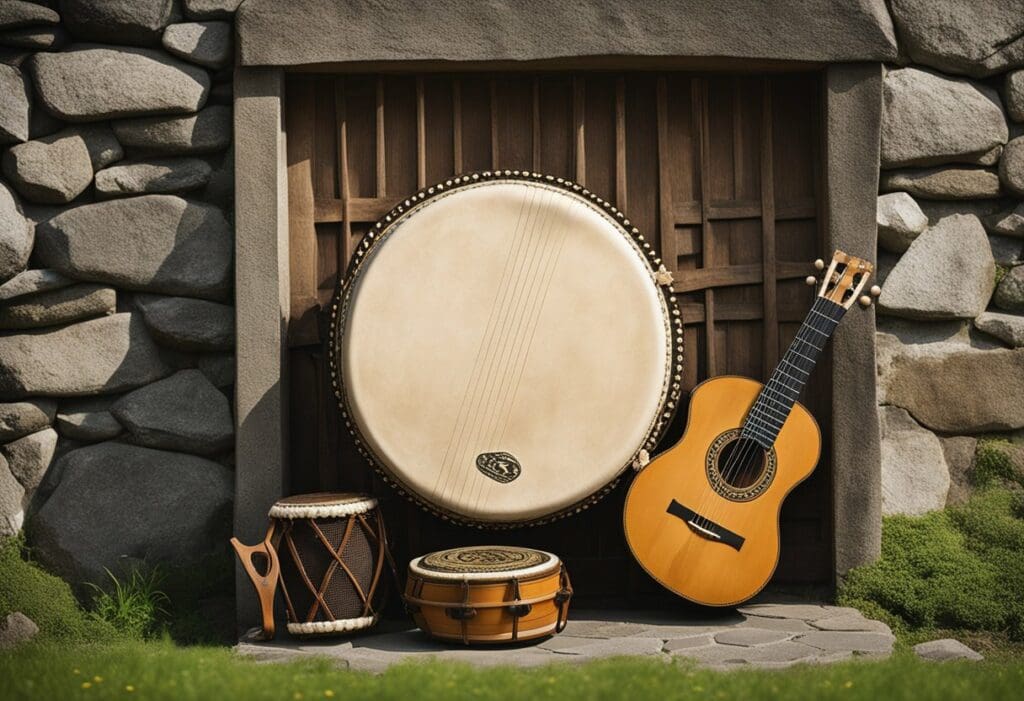
Before delving into the specific features of the bodhrán, it is worth noting that this instrument’s design is a testament to tradition and careful craftsmanship. Central to its function is the frame and the drumhead, which work together to produce its distinctive sound.
The Bodhrán’s Anatomy
The bodhrán is a type of frame drum, meaning its structure consists primarily of a wooden frame and a drumhead typically made from animal skin. In its most traditional form, the drumhead is a stretched piece of goatskin that is tautly secured over the frame, providing a resonant surface. The tension of the skin can be adjusted to vary the pitch and tonal quality of the drum.
Materials and Craftsmanship
The materials selected for a bodhrán are key to its sound and quality. Goatskin is favoured for the drumhead due to its ability to create rich, warm tones, and each piece is hand-selected based on its thickness and texture. The wooden frame is generally crafted from hardwoods like ash or oak, which ensure durability and offer a natural resonance. Skilled artisans are essential in shaping the wood and preparing the skin, culminating in a finely made, functional, and beautiful instrument.
Players use a stick known as a tipper, traditionally carved from wood, to strike the drumhead in various rhythms. The tipper’s design can vary, influencing the style of play and the resulting sound.
Playing Techniques
In exploring the bodhrán’s playing techniques, we discover the skill and precision that shape its compelling sound. Let’s delve into the core methods that define bodhrán mastery.
Holding and Handling
The way we hold the bodhrán is fundamental to control and sound quality. Typically, we grip the instrument by the side with our non-dominant hand passed through a strap behind the drum for stability. This position allows for subtle dampening of the drumhead, utilising our arm and hand to either mute or resonate the produced sound.
Striking Methods
Striking the bodhrán requires a blend of finesse and strength, using a beater known as a tipper. Straightforward strikes are the basis, but variations in angles and surfaces—playing on the edge or centre—can vastly alter the instrument’s tone. Learning different striking methods, like the rebound stroke for lighter sounds or direct hits for deeper tones, exemplifies diverse playing styles.
Advanced Styles
Within advanced styles, unique techniques are brought to bear. With a combination of wrist flicks, forearm movements, and intricate tipper work such as rolls, triplets, and syncopation, experienced players can create complex rhythms. These advanced techniques necessitate precision and can define a player’s style.
In the landscape of Irish music, the bodhrán’s rhythm is more than mere accompaniment; it expresses our cultural heartbeat, eliciting the same dedication and skill found in any cherished craft.
Musical Role and Function
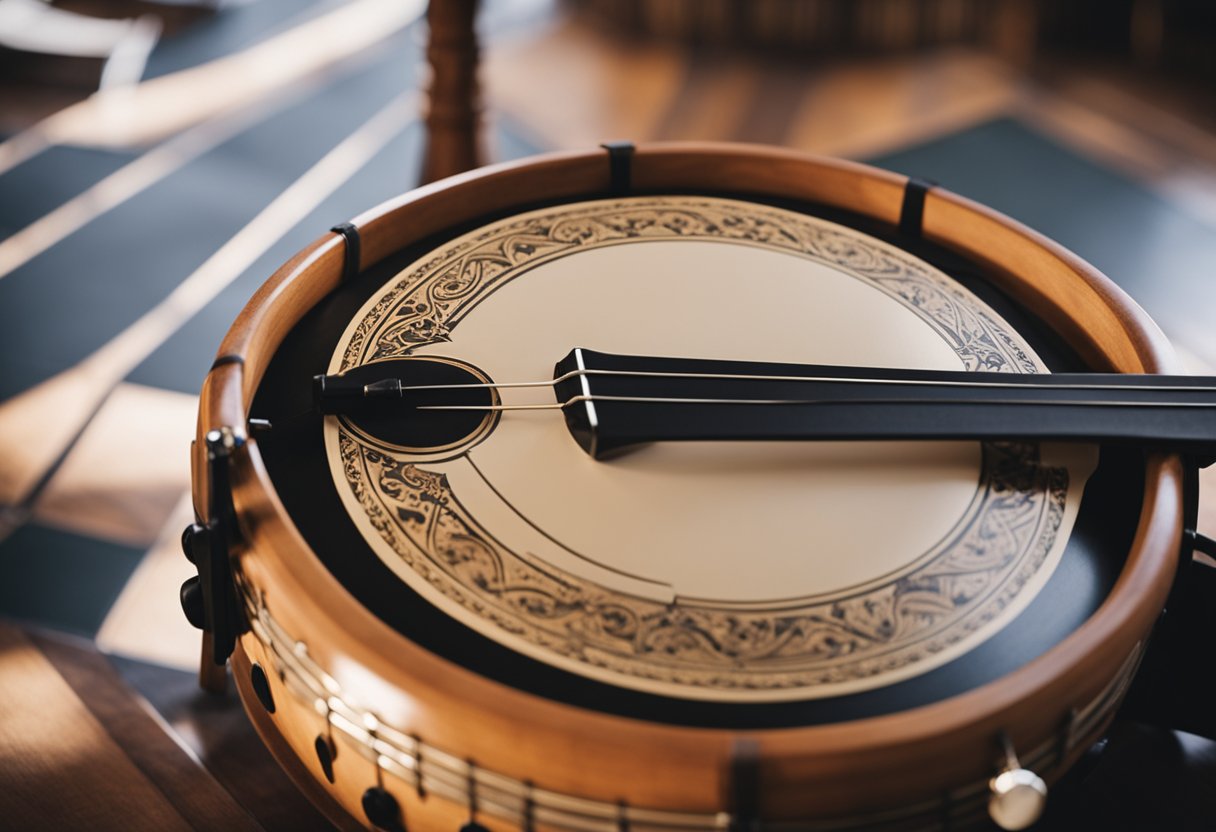
In Irish music, the bodhrán is not just an instrument; it’s a fundamental part of the ensemble that shapes the very nature of the performance.
Rhythmic Foundation
We understand the bodhrán as the rhythmic core of traditional Irish music. Its deep and resonant sound provides a steady rhythm that is essential for maintaining the pulse of the music. The player can vary the tension on the drum skin to produce different tones, adding a dynamic layer to the rhythm.
Accompaniment Patterns
Regarding accompaniment patterns, the bodhrán excels in delivering both backbeat and syncopated elements. By employing a variety of beats and rhythms, the Bodhrán player can accent certain parts of the music, complementing melodies and enriching the overall sound. This also includes producing intricate patterns that can adapt to the changing tempo and intensity of the music.
Styles and Genres
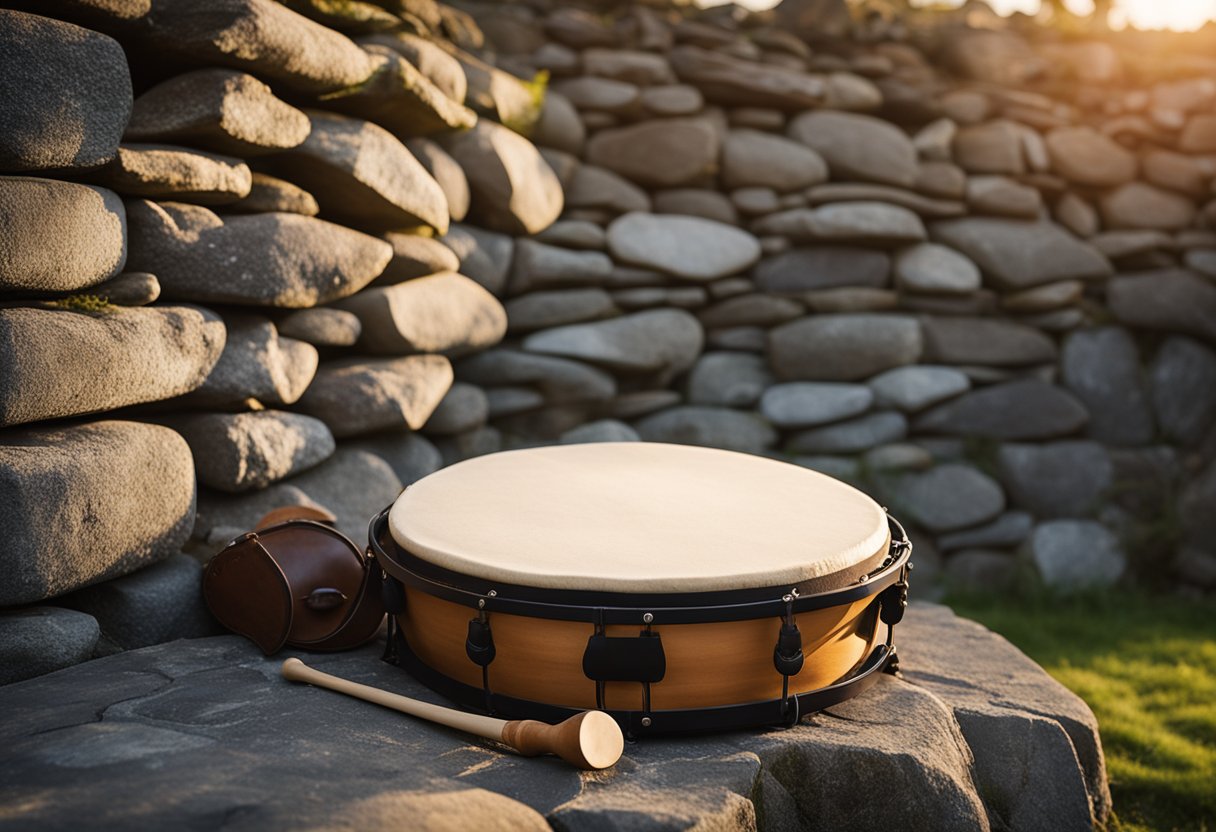
In exploring the Bodhrán’s significance, we’ll traverse through its various applications within traditional and folk settings and its evolving presence in contemporary music.
Traditional and Folk Settings
The Bodhrán is synonymous with Irish traditional music, providing a distinctive rhythmic backbone. It often accompanies dances such as jigs and reels in these settings, characterised by its responsive and dynamic play style. Its role is not merely percussive; it also supports the melody, complementing other traditional instruments like the fiddle and accordion. This interplay is fundamental to the essence of traditional Irish and folk music performances.
Bodhrán in Contemporary Music
Beyond traditionalism, the Bodhrán has found a comfortable niche within contemporary music. World music artists have embraced its distinct sound textures, offering a unique blend of heritage and modernity. By embracing eclectic music styles and infusing them with traditional Irish rhythms, the Bodhrán bridges the gap between the old and the new, introducing Ireland’s rich musical culture to global audiences.
Cultural Significance
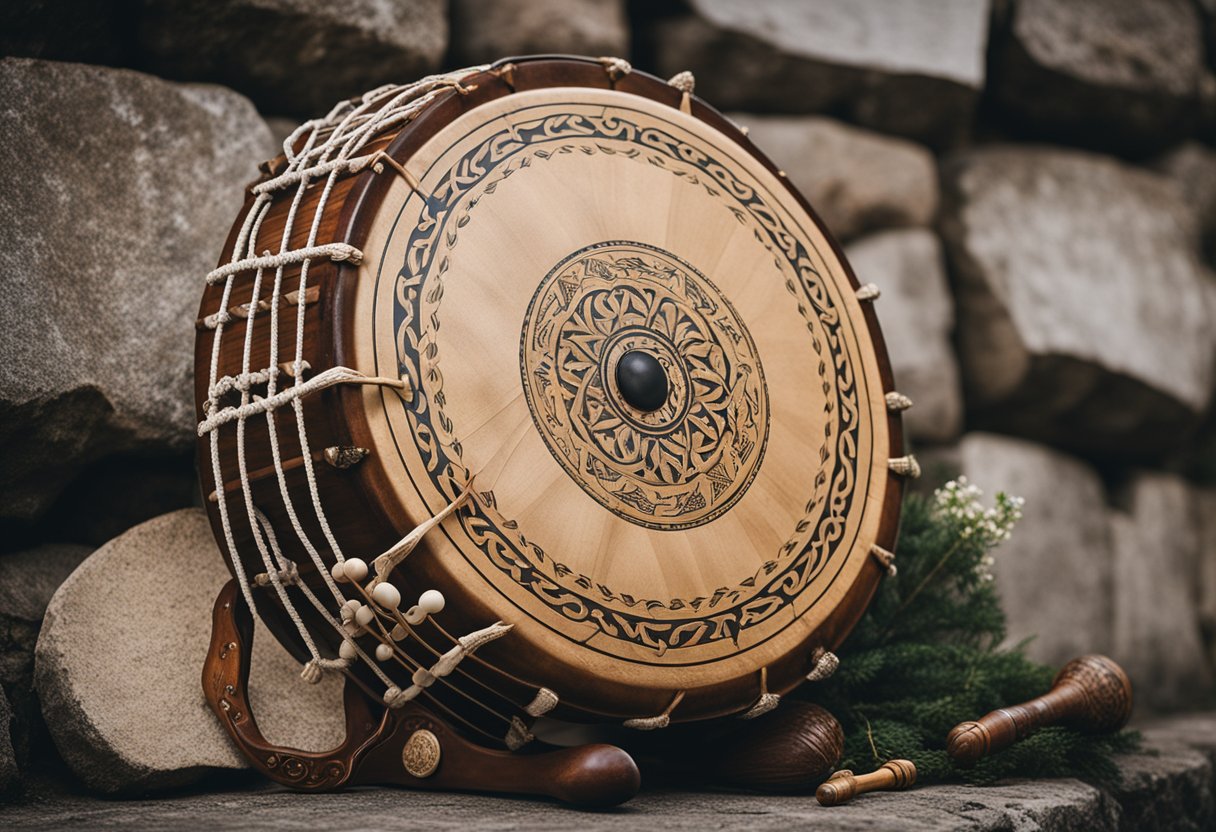
The Bodhrán, far more than simply an instrument, is a profound symbol within Irish society, embodying tradition, culture, and national identity. It resonates through the fabric of Irish life, serving as a testament to our rich heritage.
Bodhrán in Irish Society
The Bodhrán has long held a special place in Irish society, originally used in religious ceremonies and Gaelic rituals, marking it as an instrument of significant cultural reverence. Its presence is felt in pubs, festivals, and communal gatherings, where its rhythm underlines our collective narratives and shared experiences. Traditionally, the Bodhrán provided musical accompaniment, a sense of unity, and a connection to the past, often handcrafted and passed down through generations as a cherished heirloom. Its role extends beyond music as a medium through which we celebrate and solidify our cultural bonds.
Symbol of Irish Identity
Embodying a strong Irish identity, the Bodhrán is often associated with national pride and our cultural renaissance. Its distinctive sound has become synonymous with traditional Irish music and by extension, an audible icon representing our nation’s story. As we perform on the global stage, the Bodhrán serves as a cultural ambassador – its frame and skin are a canvas portraying Ireland’s history, from ancient times to its contemporary role, perpetuating Gaelic traditions in the modern era. It’s a craft deeply woven into our cultural tapestry, offering both a rhythmic foundation for melodies and a potent symbol of our enduring heritage.
Innovation and Adaptation
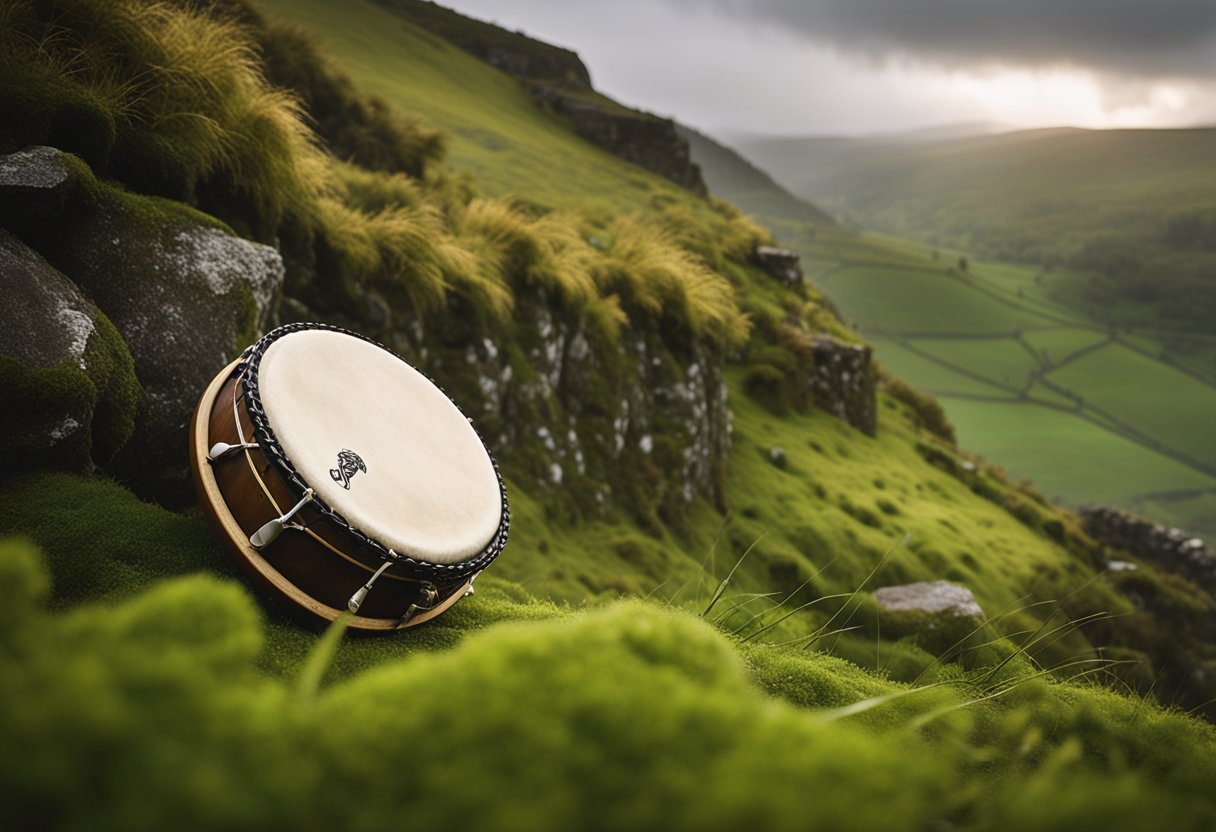
As we delve into the bodhrán’s evolution in Irish music, we witness a remarkable journey of innovation and adaptation. This traditional Irish drum has not only modernised Celtic music but has also influenced world percussion.
Modernisation of Playing Styles
The bodhrán has experienced a transformative evolution in playing styles, from being a simple timekeeper to a sophisticated instrument capable of complex rhythms and tones. Innovations include introducing new playing techniques, such as the top-end style, which offers a range of dynamic sounds and has propelled the bodhrán to the forefront of Celtic music. The evolution of the tipper, or beater, with its varying shapes and weights, also plays a pivotal role in modernising playing styles, providing players with the means to extract a rich palette of sounds from the drum.
Influence on World Percussion
The bodhrán’s distinct sound and versatile nature have resonated beyond Irish music, garnering attention in the broader world music scene. Its unique voice has found a place in a diverse array of musical genres, demonstrating its adaptability and the influence of Celtic music on global scales. The drum’s simple frame and skin construction, paired with the creative potential it offers, have invited percussionists from disparate cultures to incorporate the bodhrán into their musical traditions, fostering a cross-cultural exchange of rhythmic innovations.
Notable Players and Influences
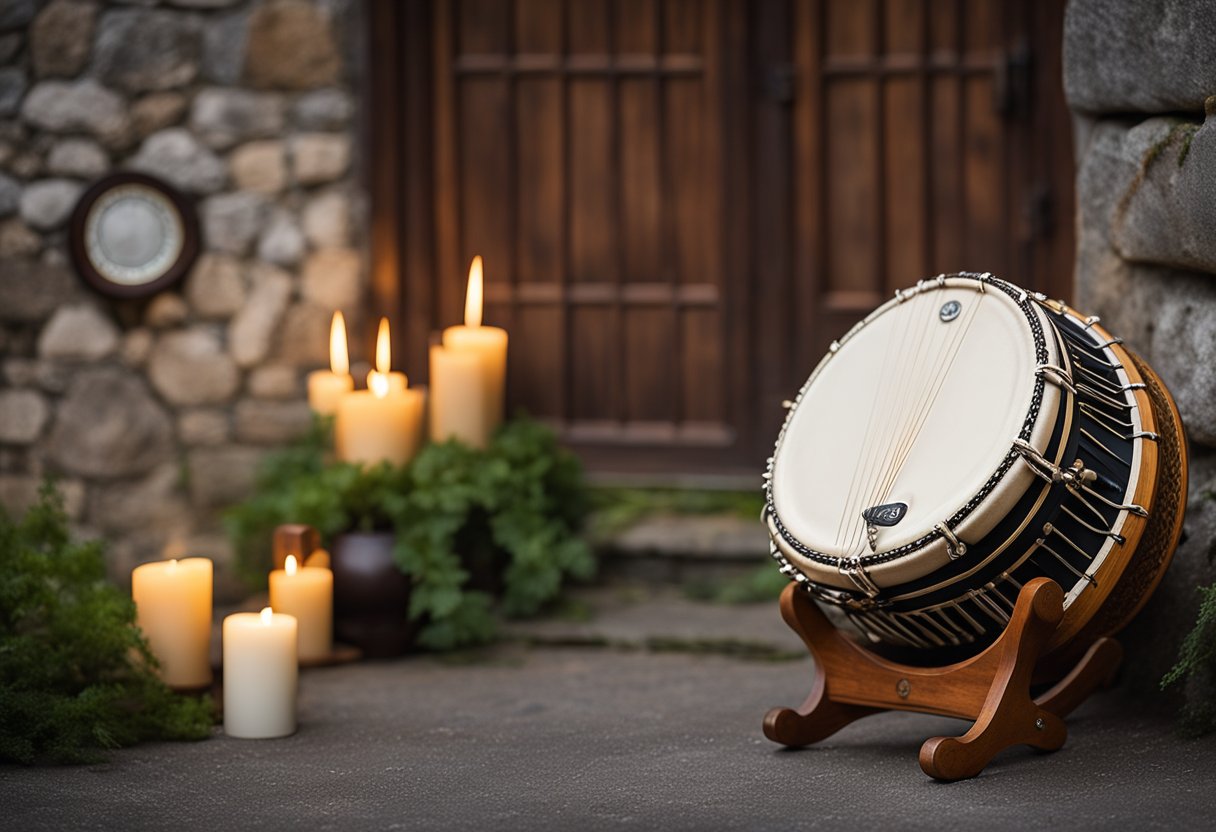
The bodhrán, a distinctive Irish frame drum, owes its worldwide recognition to the talent and creativity of its players. Pioneering and contemporary artists have contributed significantly to the instrument’s evolution in traditional Irish music.
Pioneers of the Bodhrán
- Peadar Mercier: A pivotal figure in popularising the bodhrán, he brought a new level of recognition to the instrument during his time with the legendary group, The Chieftains.
- Johnny McDonagh: Renowned for his innovative techniques, McDonagh played a key role in changing perceptions of the bodhrán as a simple accompaniment to being a central instrument of Irish music.
Contemporary Maestros
- John Joe Kelly: Kelly’s expertise and speed have made him one of the most respected bodhrán players in the contemporary traditional music scene.
- Kevin Conneff: Conneff, the heartbeat of The Chieftains, is admired for his soulful playing and has also guided the next generation of players.
- Anna Colliton: A talented American bodhrán player, she has carved a space for herself in this traditionally male-dominated arena.
- Mel Mercier: Son of Peadar Mercier, Mel continues his father’s legacy through his profound contributions to the Irish percussion world.
The admiration for these musicians goes beyond their ability to play; it encompasses their influence on the cultural and musical landscape of Ireland.
Acquisition and Learning
Embarking on the journey to learn the bodhrán, one must consider both the selection of a suitable instrument and the utilisation of rich educational resources. Whether you’re looking to embrace your musical heritage or develop a new skill, we guide you through buying your first bodhrán and dig into learning materials that can support your musical ambitions.
Choosing the Right Instrument
When seeking to buy a bodhrán, it’s important to select one that complements your playing style and comfort. Size plays a crucial role; a smaller bodhrán is more manageable for beginners, but a larger one tends to offer a fuller sound. Material quality also affects durability and tone – traditionally, bodhráns feature a wooden frame and a goatskin head. Options vary from beginner to professional levels, each with its unique character and sound. To immerse fully in the musical heritage of Ireland, finding an instrument that feels as good as it sounds is key.
- Size Assessment:
- 18″ is standard and versatile.
- Larger sizes offer deeper tones; smaller sizes are higher-pitched.
- Frame and Build:
- Wooden frames are typical.
- Check for solid construction and smooth finish.
Educational Resources
Once your instrument is in hand, it’s time to learn. Books and online courses abound, providing step-by-step instructions on basic rhythms to advanced playing techniques. Engaging with these materials can significantly shorten the learning curve. It’s vital to access resources that include visual aids and audio samples, which can be immensely helpful in developing the necessary skills.
- Learning Aids:
- Visual: DVDs, YouTube tutorials.
- Auditory: CDs, online sound clips.
- Structured Guidance:
- Books: “Absolute Beginners: Bodhrán” is an excellent starting point.
- Classes: Join local Irish music workshops or online communities.
By carefully choosing the right instrument and investing in high-quality educational resources, we set ourselves up for an enriching journey into the heart of traditional Irish music.
Maintenance and Tuning
To ensure the bodhrán continues to produce its distinctive Irish rhythms, appropriate maintenance and precision tuning are crucial. These processes safeguard the drum’s sound quality and adapt its pitch to various musical contexts.
Preservation of Sound Quality
The sound quality of a bodhrán can last for years with proper care. Regularly wipe the skin with a damp cloth to remove dirt and oils; this prevents degradation of the material and maintains the drum’s resonance. Avoiding excessive moisture is vital, as too much can warp the frame and skin, leading to a loss of tone quality. When not in use, it’s best to store the bodhrán in a temperature-controlled environment to prevent the skin from becoming too tight or too slack, potentially harming the sound.
Tuning Systems and Practices
Bodhráns come with various tuning systems. Traditional models often lack a tuning mechanism and rely on the ambient temperature and humidity to tighten or relax the skin. However, modern bodhráns frequently feature hardware tuning systems, allowing players to adjust the tension of the skin, thus altering the pitch. Using a tuning wrench, we uniformly tighten or loosen the tuners around the drum’s frame to achieve the desired tone. It’s essential to turn the tuners gradually and evenly to ensure a harmonious sound that complements the rich timbre essential in Irish music.
Frequently Asked Questions
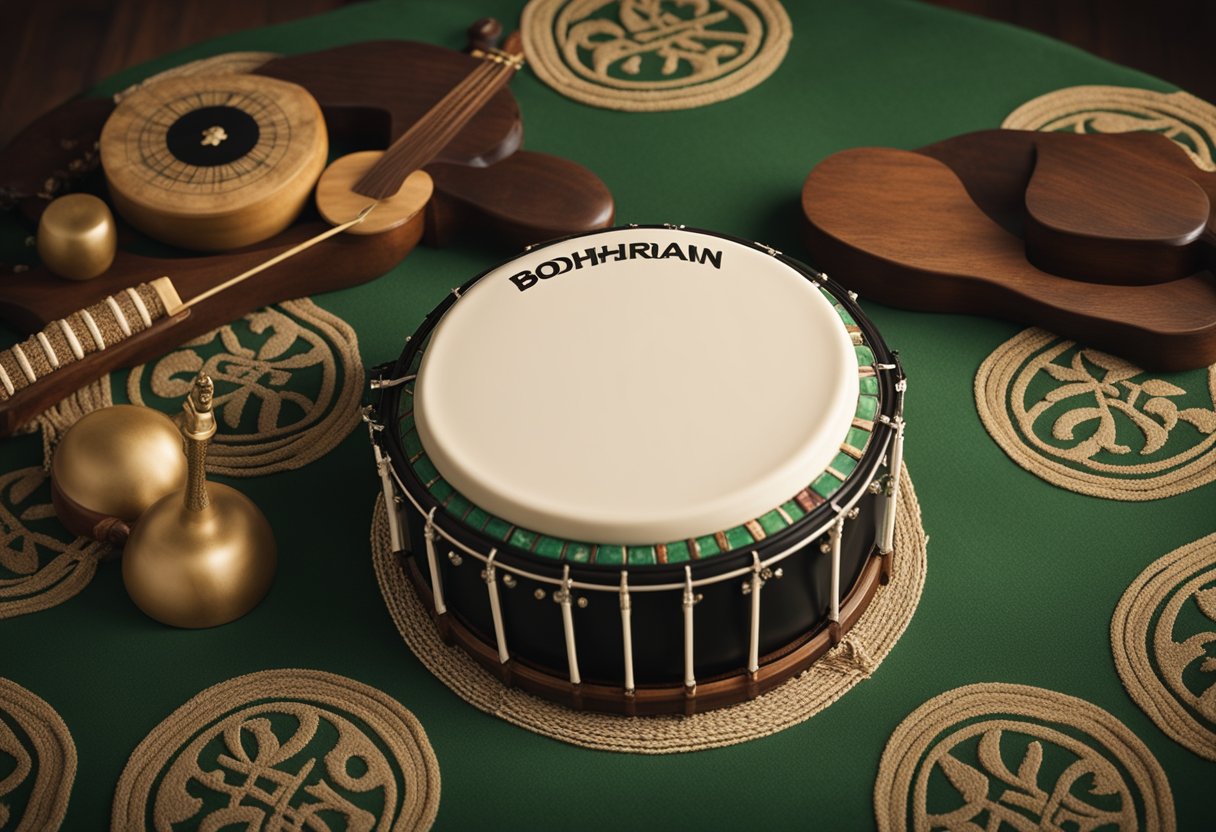
We’ve gathered some of the most common queries people have about the bodhrán, its significance in Irish culture, and tips for those wanting to learn this captivating instrument.
What techniques are fundamental for playing the bodhrán in traditional Irish music?
Mastering the bodhrán requires learning various hand and stick techniques. A fundamental skill is the ability to control the tipper, or beater, to produce different tones and rhythms, while another is managing the hand placed behind the drum skin to change pitch and timbre.
Which type of bodhrán is recommended for someone starting out in Irish music?
Beginners should consider a ‘bare back’ bodhrán, which typically doesn’t have crossbars at the back. This design allows for more control over the tone and is easier to handle when learning the basic techniques.
Where can one find authentic bodhrán lessons that focus on Irish cultural elements?
Authentic bodhrán lessons that integrate Irish cultural elements can be found at Online Academy of Irish Music, offering material ranging from basic strokes to advanced playing techniques with a focus on traditional Irish music styles.
What is the significance of the bodhrán in Irish music history and culture?
The bodhrán holds special significance in Irish music and culture as both a symbol of Irish identity and a central piece in traditional music ensembles. It plays a crucial role in maintaining the rhythm and enhancing the dynamism of Irish music.
How is a bodhrán constructed and what materials are traditionally used?
Traditionally, a bodhrán is constructed with a wooden frame and a goatskin head, tensioned and tacked onto the frame. Modern makers sometimes employ tunable systems to adjust the skin’s tension for different tones.
Can the origins of the bodhrán be traced to Irish heritage, and how is it differentiated from other Celtic drums?
The bodhrán is an intrinsic part of Irish heritage with roots possibly stretching back to the Celts. It is recognized by its frame drum shape and the adaptability of its playing styles, setting it apart from other Celtic drums.


